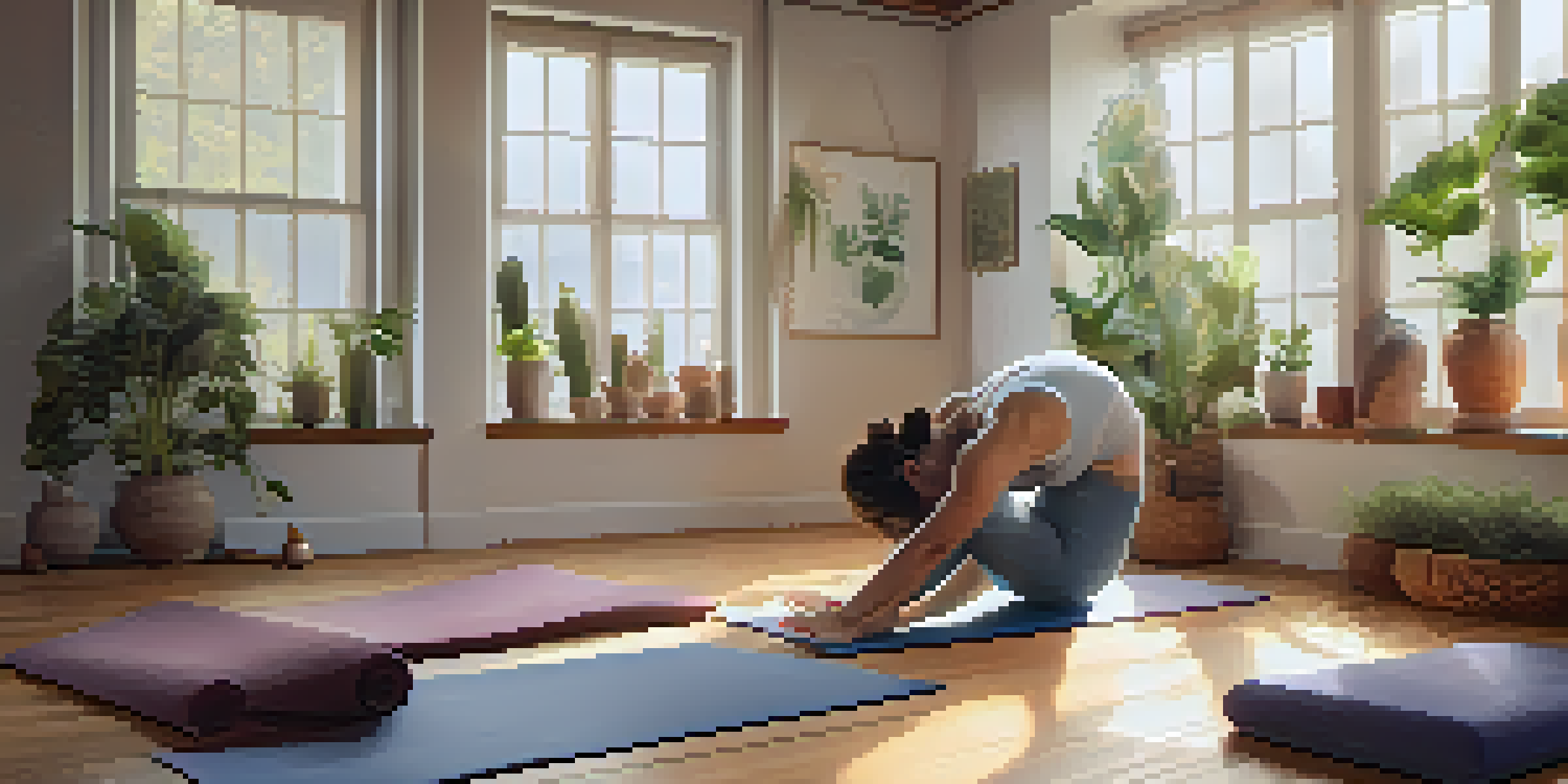Integrating Breathwork into Your Restorative Yoga Practice

Understanding Breathwork and Its Benefits
Breathwork encompasses various techniques that focus on conscious breathing. These practices can help calm the mind, reduce stress, and promote relaxation, making them a perfect complement to restorative yoga. By engaging in breathwork, we can tap into the body's natural ability to heal and rejuvenate.
The breath is the bridge between the body and the mind.
In restorative yoga, the aim is to foster a deep state of relaxation, and breathwork can significantly enhance this experience. For instance, using methods like diaphragmatic breathing can lower heart rates and encourage a sense of peace. As a result, you not only feel more relaxed but also more connected to your body and mind.
Moreover, breathwork can help deepen your awareness during yoga practice. By focusing on your breath, you can anchor your thoughts and cultivate mindfulness, allowing for a richer experience on the mat. This connection may lead to greater emotional release and clarity as you move through your restorative poses.
Preparing for Your Yoga Session: Setting the Scene
Before you begin your restorative yoga session, it’s essential to create a calming environment. This might include dimming the lights, playing soft music, or using essential oils to enhance the atmosphere. When your surroundings promote tranquility, it becomes easier to focus on breath and movement.

Consider gathering props like blankets, bolsters, and straps, as these can support your body during restorative poses. The more comfortable you are, the easier it will be to engage with your breathwork. Remember, the goal is to feel relaxed and supported throughout your practice.
Breathwork Enhances Relaxation
Conscious breathing techniques like diaphragmatic breathing promote calmness and deeper relaxation during restorative yoga.
Finally, take a moment to set an intention for your session. This could be as simple as wanting to connect more deeply with your breath or seeking greater mindfulness. Setting an intention helps guide your practice and keeps you centered as you explore breathwork and restorative yoga.
Incorporating Breathwork Techniques into Your Practice
One effective technique to integrate is the 4-7-8 breathing method. Inhale for a count of four, hold for seven, and exhale for eight. This pattern can help slow your heart rate and promote relaxation, making it an excellent addition as you settle into restorative poses.
Breath is the vital source of life, its movement is the rhythm of our existence.
As you transition between poses, try to synchronize your breath with your movements. For example, inhale as you gently lift into a pose and exhale as you settle deeper. This practice not only enhances your physical experience but also encourages mindfulness and body awareness.
Lastly, don't shy away from experimenting with different breathwork techniques. Whether it's box breathing, alternate nostril breathing, or even simple deep belly breaths, find what resonates with you. Each technique can offer unique benefits and help you discover new layers of relaxation in your practice.
Deepening Your Breath During Restorative Poses
As you hold restorative poses, focus on deepening your breath to enhance relaxation. This can be achieved by visualizing your breath filling your body, expanding your ribcage, and softening your muscles. Imagining your breath flowing like a gentle wave can help you settle into the pose more comfortably.
You can also use a mantra or phrase to guide your breath. For instance, silently repeating 'Inhale calm, exhale tension' can create a soothing rhythm and help clear your mind. This practice allows you to cultivate a more profound connection between your breath and body.
Create a Calming Yoga Environment
Setting a tranquil atmosphere with soft lighting, soothing music, and supportive props enhances your yoga experience.
Be attentive to how your body responds to your breath. If you notice areas of tightness or discomfort, adjust your position or breathe into those areas. This mindful approach encourages a deeper release and fosters a more restorative experience, allowing you to truly unwind.
Using Breathwork to Enhance Meditation
Integrating breathwork into your meditation practice can elevate your overall restorative experience. Before or after your yoga session, take a few moments to focus solely on your breath. This practice helps clear your mind and prepares you for a more profound meditative state.
For instance, you might practice a simple breath count during meditation. Inhale deeply for a count of five, hold for a count of five, and exhale for a count of five. This rhythmic breathing can anchor your thoughts and deepen your relaxation, enhancing your meditative experience.
Additionally, consider visualizing your breath as a soothing light or energy that flows through your body. This imagery can help promote a sense of calm and connection, allowing you to sink deeper into both your meditation and restorative poses.
Listening to Your Body: The Key to Effective Practice
One of the most crucial aspects of integrating breathwork into your restorative yoga is listening to your body. Each person's experience is different, and it's important to honor what feels right for you during your practice. Pay attention to any signals your body may send, whether that's discomfort or a sense of deep relaxation.
As you explore various breathwork techniques, notice how they impact your body and mind. If something doesn’t feel right, don’t hesitate to modify or try a different approach. Flexibility in your practice allows for a more authentic and personal experience.
Listen to Your Body's Signals
Honoring your body’s feedback during practice is essential for a personalized and effective restorative yoga experience.
Remember, restorative yoga is about finding stillness and comfort. By tuning into your body and breath, you can create a practice that truly supports your needs, enhancing both your physical and emotional well-being.
Post-Practice Reflection: Embracing the Benefits
After completing your restorative yoga session, take a moment for reflection. How do you feel physically and emotionally? This time for introspection can help reinforce the benefits of your practice and deepen your understanding of how breathwork influences your overall well-being.
Consider journaling about your experience. Writing down your thoughts and feelings can provide insights into your personal growth and progress. This practice not only helps consolidate your learning but also encourages you to celebrate your journey.

Finally, carry the lessons learned from your breathwork and yoga practice into your daily life. Practicing mindful breathing throughout the day can help you manage stress and maintain a sense of calm, allowing for a more balanced lifestyle.